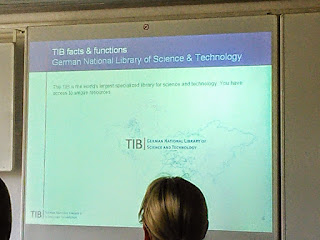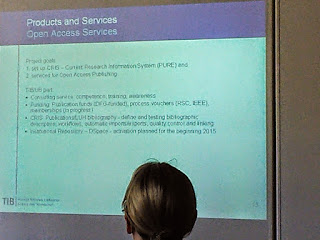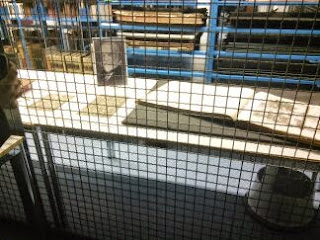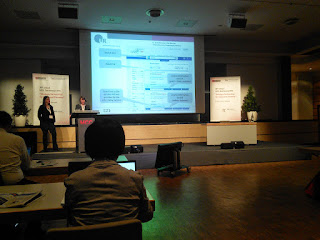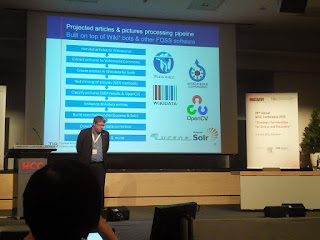DAY 4
THE FUTURE IS ALREADY HERE … SHORT PRESENTATIONS
EVELINDE HUTZLER/SILKE WEISHEIT: “EASY ACCESS TO OPEN ACCESS: INTEGRATION OF OPEN ACCESS PUBLICATIONS INTO THE EZB LINKING SERVICE”
The first speakers of the morning outlined the EZB link resolver service [http://ezb.uni-regensburg.de/] from the University of Regensburg, how it is used by almost all German institutions, and over 125 international one’s, including the Library of Congress. It has access to the metadata of 80,800 journals, which is collectively collaboratively gathered. The linking services checks for full text availability against the metadata and returns results using a traffic light coding system, to indicate availability or lack thereof. The system leverages OpenURL, and offers results based on the IP origin of the query, responding to millions of requests a day.
The EZB service hopes to improve its direct article linking, especially for open access publications, and repositories. They have also worked with Bielefeld University on the base-search.net search engine for academic publication searching [http://base-search.net/], which allows ‘open’ documents to be boosted within the results listing.
LAMBERT HELLER: “AUTOMATIC HARVESTING, INDEXING AND PROVISION OF MULTIMEDIA OPEN ACCESS OBJECTS USING THE INFRASTRUCTURE OF WIKIMEDIA COMMONS AND WIKIDATA”
Mr. Heller detailed the case for the handling of pictures / images within publications, especially those with unique information content. He highlighted that some images have their own DOI allowing them to be cited separately from their original document of publication. These pictures can help understand a search result while browsing, and some can / have been licenses for reuse, as open educational resources (OER), on MOOC’s, in PowerPoints, in the press. Images can cross language barriers and are therefore a powerful tool for conveying research results. It was observed that the Google images search for reusable images currently has a low rate of precision, and that some disciplines are now highly centred on digital imagery (biology, medicine, geography).
Mr. Heller went on to detail a text mining project leveraging Wikipedia and Wikidata [https://www.wikidata.org/wiki/Wikidata:Main_Page ] , to identify peer reviewed images. Wikipedia was chosen because it is usually returned in the top results by search engines, and is all about open access. Data was put into the Wikimedia [https://www.wikimedia.org/] commons and viewed on Wikidata to identify peer reviewed images. This approach is similar to how the google knowledge graph that is created from Wikidata. It was noted that there are some very advanced image recognition projects currently via Wikimedia.
SVEN STROBEL: “SEMANTIC VIDEO RETRIEVAL OF THE TIB|AV-PORTAL”
Mr. Strobel highlighted the TIB’s video portal [https://av.getinfo.de/?0], which allow for +2900 videos / 1900 films [mostly open access] to be searched, using automatically generated metadata. Named Entity Recognition is leveraged to for the index. An algorithm is used to disambiguate the terms. The resultant taxonomic schema is only partly semantic, with the German name registry [GND] providing sub-heading for the semantic part. Thesauri were included to increase synonym matching.
PALOMA MARÍN ARRAIZA: “VIDEO ABSTRACTS: A NEW WAY OF SCIENTIFIC COMMUNICATION”
Ms. Arraiza spoke of the use of video abstracts as a method of scientific communication, as it allows the author to focus on the intelligibility of their abstract content, while allowing data to be represented in a way that is beyond 2D. ACRL have guidelines for dealing with videos, while the TIB AV Portal allows citation and archiving via DOI. This also allows for the tracking of use for impact measurement. Possible issues still need to be addressed in the area of file size, workflows, rights and impact measurement, in addition to linking for semantic searching.
INA BLÜMEL: “COMPLEMENTING A RESEARCH LIBRARY’S KNOWLEDGE MANAGEMENT USING VIVO”
Ms. Blümel spoke of Vivo [http://www.vivoweb.org/] as a research information management system. This open source system is well maintained by the user community, and allows for the identification of sources. Open Refine [http://openrefine.org/] was used to try to create linked name spaces, as the information is no longer in unavailable silos. Alternatives such as Elsevier Pure, [https://www.elsevier.com/solutions/pure], and Research Gate [http://www.researchgate.net/] were all discussed.
CHIA YEW BOON: “IT ALL STARTED WITH BLOGS: DEVELOPING NEW ROLES FOR LIBRARIANS IN COLLABORATING WITH FACULTY ON TEACHING, LEARNING AND RESEARCH”
Mr. Boon spoke of the library’s decision to provide a blog services to staff and students. This service sees 1/3 of its traffic from outside of the Nan yang TU Campus. One issue is that students prefer ease over quality. The service is provided via a server configured to run WordPress, this allows the URL to include NTU, and makes the blog more ‘official’. Training, new feature introduction and design are all provided. As are the integration of library resources and the migration of blog content to other platforms. Some students have to create a blog as part of assignments. For example Art students use it to create an online personal portfolio over the 4 years of their study. This service, while self-maintained, allows for the exposure of academic research beyond the confines of the campus. It resides within the library sphere because of the staff’s skills and information awareness.
WOLFGANG STILLE: “MOBILE DISCOVERY FOR LIBRARIES AND MUSEUMS”
Mr. Stille outlined how at Darmstadt all patrons bring at least one device with them, hence, the decision to create an app to expose the collection of the library and museum to the wider world. An app is suitable in this case as the museum alone has +110,000 items which can be more easily viewed and browsed via the app than a static web page. Funding was received from the Louvre for the project. Html 5 and JavaScript were used as the base of the app to allow it to be compatible with all devices. A topic pie leverages metadata to create browse-able facets. Future plans for additional features include: personalization, a recommender, present old scanned stock, and investigating licencing with an industrial partner.
OLIVER BRIDLE: “3D PRINTING AND SCANNING: NEW WAYS TO ENGAGE WITH STUDENTS AND RESEARCHERS”
Mr. Brindle outlined the introduction of 3D printing at the Radcliffe Library. The library has a proactive strategy to provide services that the researcher would not normally expect. Options for file creation include CAD (which requires maths, design, flair and training), or online repositories of prepared files. Creative Commons licensed files can be downloaded from these and modified. One example of this is Thingyverse [https://www.thingiverse.com/]. Scanning an existing object is another option.
Before undertaking the project the library established the extent and general availability of other 3D printing facilities on campus. Existing services were not open for use beyond those in the Department where they were located. The library decided to offer the service as it ties into the strategy of providing access to new technologies, as evidenced by the previous projects to introduce iPads and Kindles to campus.
As the library is not trying to make a profit from the services, they can afford to run it cheaply. The selected printer uses PLA which is non-toxic. The user provides a .stl file, staff check the file is sound and there are no issues with copyright, calculate the length of time required for the print job to run, and the user pays upfront. Items are available the following week. The week of the service launch there were a series of events highlighting 3D printing research.
The printer is noisy, but the service is so in demand that a second printer has had to be installed.
CLOSING SESSION
PRESENTATION OF THE 37TH IATUL CONFERENCE, 2016.
The next conference will be in Halifax, and attendees were introduced to the city and the theme "Library Leadership in a Sea of Change: At the Bowsprit of Service” by the hosts.


